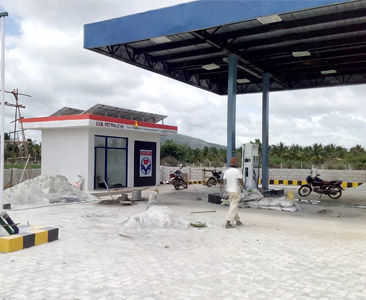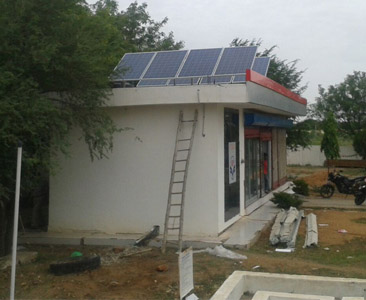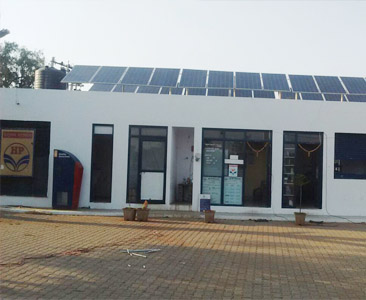
 This SOLAR POWER PACK is state of art Renewable Energy product which produces clean energy from Solar and converts into Electrical Energy and this specially designed to supports Petrol Pump motors and its related Electrical loads like computers, LED lights, Fans and other sensitive related loads . Solar power pack consists of Solar Photovoltaic modules, Battery and Solar Inverter along with accessories.
This SOLAR POWER PACK is state of art Renewable Energy product which produces clean energy from Solar and converts into Electrical Energy and this specially designed to supports Petrol Pump motors and its related Electrical loads like computers, LED lights, Fans and other sensitive related loads . Solar power pack consists of Solar Photovoltaic modules, Battery and Solar Inverter along with accessories.
The Solar Photovoltaic modules are mounted on the Roof top of the building. The battery and Solar PCU are housed inside the building. During the day time solar modules generates the DC power and this power is stored in the battery and simultaneously supplies to loads . The inverter which connected across the battery draws this DC power from battery and converts into AC power which is fed to the load. The Inverters are specially designed to take care of high surge load and generates pure Sine wave 220V AC output to power Petrol Bunk pumps and Lighting load. It has a dual SOLAR-GRID charger with advanced intelligence logic to automatically select either SOLAR power as priority or ac mains to power up the loads. It has advanced protection system to make it one of the most rugged SOLAR Electric Power generating system available.
Since the solar cells are generally of limited linear dimensions, a number of such cells are to be interconnected to provide required voltage and current to the ‘Load’. Such interconnected solar cells constitute a ‘SPV Module’.
These SPV modules come in a wide range of power capacities. Depending on the load power requirement, such modules are further interconnected in series and/or parallel to constitute a ‘SPV Array’. SPV modules are rated in ‘Peak Watts’ (Wp) (Power generated when solar radiation is normally incident on the cell).
Each PV module consists of number of solar cells ( 72 or 60 cells ) electrically connected in series & laminated in between two layers of EVA sheets with high transmission, toughened glass on top & polyester- TEDLAR- polyester at the back.TheSPV module is designed to withstand most severe weather conditions for longer life.
 Batteries are essential component in a SPV system, where energy has to be stored during the day and used whenever required. A typical application are the solar lighting system, UPS Telecom etc. The type of battery used is Flooded Electrolyte Positive tubular plate Low maintenance lead acid battery. The batteries are connected in series parallel combination to get the required systems voltage.
Batteries are essential component in a SPV system, where energy has to be stored during the day and used whenever required. A typical application are the solar lighting system, UPS Telecom etc. The type of battery used is Flooded Electrolyte Positive tubular plate Low maintenance lead acid battery. The batteries are connected in series parallel combination to get the required systems voltage.
The solar power condition units consist of sine wave inverter, solar MPPT charger and grid charger. The PCU are designed with intelligent logic such way that during the day time it selects solar as first priority solar energy is utilized maximum and support the load. The second priority is battery where in the stored power is discharged till to the pre-defined level. The last priority is switched to grid when the battery is discharged beyond the cut off level.
The Inverter is High efficient PWMMOSFET based Sine-wave Inverter. The inverter is having highly stable sine wave voltage and frequency with 16 bit Digital Control. It has got all necessary protection to take care of the different load. Inverter works normally on Solar priority. It has built-in intelligent logic to monitor the state of charge and switch on the mains charger whenever it is required. The main advantage of our Inverter is that the mains power is drawn only when the battery needed charge and is controlled by an intelligent logic provided in the unit. And hence it reduces the cost on the grid power as compared to other Inverter available in the market.
The SOLAR MPPT charger charges the battery whenever the SOLAR energy is available.
The Solar charger is of MPPT (Maximum Power Point Tracking type). This MPPT is having three level charging topology like Bulk, Absorption and Float charging. The first is bulk charging, where up to 80% of the battery energy capacity is replaced by the charger at the maximum voltage and Amps rating of the charger. When the battery voltage reaches 2.4V/Cell this begins the Absorption charge step. This where the voltage is held at a constant 2.4V/Cell and the current (amps) declines until the battery is 98% charged. Next comes the Float step. This is a regulated voltage of not more than 2.3V/cell and usually less than 1 amps of current. This in time will bring the battery to 100% charged or close to it. The float charge will not boil or heat batteries but will maintain the batteries at 100% readiness.
The Grid charger is used to top up the battery in case the SOLAR energy is insufficient.
The microcontroller continuously monitors the SOLAR PV panel Voltage, the battery Voltage, the ac line Voltage and frequency and controls the operation of the charger
The Grid charger deploys a three stage constant current - constant voltage – trickle charge method to keep the battery fully charged.

SL No. |
PETROL PUMP LOAD |
SOLAR PANEL RATING |
SOLAR INVERTER RATING |
BATTERY RATING |
BACK UP HOURS PER DAY |
1 |
Two Nozzle with a
|
1500Wp – 2000Wp |
5KVA 72V |
100Ah/120Ah |
4 to 6 hours per day |
2 |
Two to four Nozzle with a |
2000Wp- 3000Wp |
7.5KVA- 96V |
100Ah/120Ah/150Ah |
4 to 6 hours per day |
3 |
Four-six Nozzle with a |
3000Wp- 5000Wp |
10 KVA- 120 V |
120Ah/150Ah/1800Ah |
4 to 6 hours per day |
4 |
Six-eight Nozzle with a |
6000Wp- 8000Wp |
12.5KVA 144V |
150Ah/180Ah/200Ah |
4 to 6 hours per day |
Note:
1. Further to suit your specific needs it can be custom designed, there may be extra costs for the custom design.
2. Specifications are subjected to change without prior notice.
|
SOLAR POWER PACK |
DIESEL GENERATOR |
REGULAR UPS |
Environmental conditions |
Clean Energy to generate the power and no pollution and sound |
Uses the fossil fuel to generate the power Generates the pollution and sound |
Uses the fossil fuel to generate the power |
Maintenance |
Low maintenance |
Needs maintenance |
Low maintenance |
Running cost |
Replacement of battery every 5- 6 years as batteries used are C10 rate. Solar panels life is more than 25 years |
Very High as diesel is required to run and mechanical wear and tear is high. |
Battery replacement is frequent as the batteries are C20 rate and recurring Electrical energy bills |
Return of Investment |
After Return on investment of 6-8 years, |
Zero Return on Investment |
Zero Return on Investment |
Dependability on Grid power |
Needs minimal or zero grid power. Independent of Grid Power |
Directly |
Grid power to recharge might not available at all times, Directly |